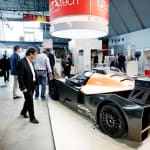 No other industry has drawn more public attention to glass- and carbon-fibre reinforced plastics (GFRP/CFRP) than the automotive industry. Next to the aerospace industry, it’s one of the innovation and growth drivers for composites. The great significance of composites for the automotive industry must be credited to the continuing lightweight construction trend. From 19 to 21 September, Composites Europe in Stuttgart will show how the composites industry can support automakers and their suppliers in this area. Programme highlights include the Focus Day Automotive and the Lightweight Technologies Forum.
No other industry has drawn more public attention to glass- and carbon-fibre reinforced plastics (GFRP/CFRP) than the automotive industry. Next to the aerospace industry, it’s one of the innovation and growth drivers for composites. The great significance of composites for the automotive industry must be credited to the continuing lightweight construction trend. From 19 to 21 September, Composites Europe in Stuttgart will show how the composites industry can support automakers and their suppliers in this area. Programme highlights include the Focus Day Automotive and the Lightweight Technologies Forum.Presentation of the study “Lightweight Construction as Innovation Factor”
When it comes to composites in the automotive sector, modern lightweight construction is the No. 1 topic, according to industry expert Rainer Kurek, CEO of AUTOMOTIVE MANAGEMENT CONSULTING GmbH (AMC) from Penzberg near Munich. After all, he says, it comprises all the aspects of lightweight automotive construction - from concept, functions and joining technologies to materials. The training and consulting company specialises in auto-industry strategies, processes and structures; together with Composites Europe organiser Reed Exhibitions, they will, on 21 September, present the study “Lightweight Construction as Innovation Factor” (“Leichtbau als Innovationsfaktor” in the original German), which takes a holistic and detailed look at the issue. “Created in cooperation with Reed Exhibitions, the market study ‘Lightweight Construction as Innovation Factor’ synthesises the German automotive industry’s knowledge from nearly 150 years of experience”, explains Kurek. “Against the backdrop of increasing environmental and climate-protection requirements, a fragile energy supply and the resulting more stringent resource-conservation targets, it serves to sustainably enhance and strengthen Germany’s role as a centre of innovation.” The developer says he used to think in terms of materials first, but “design engineers today approach lightweight construction with an integrative mindset – with other joining and production technologies as well as with new materials. These days, the typical tasks we get from OEMs are almost always based on integrative lightweight construction.”Positive outlook
With about a third of the GFRP materials produced in Europe being used in the transport sector, innovations and the current development status of composites for the automotive market will be emphasised in the exhibition halls of Composites Europe 2017, as well. The future looks bright, according to Composites Germany’s latest market survey. No fewer than 46 per cent of responding companies expect this segment to grow. Only 15 per cent anticipate a downturn. The automotive industry isn’t just one of the biggest buyers of thermoplastic composites, it’s also a major purchaser of thermoset materials like SMC. Exhibitors such as Saint Gobain Performance Plastics, capricorn COMPOSITE, Lange+Ritter, SGL TECHNOLOGIES GmbH, ARKEMA France, Cevotec and EMS will be onsite to address the automotive industry’s composites requirements.
Rainer Kurek, CEO, Automotive Management Consulting GmbH (Source: AMC)


